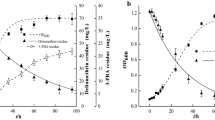Abstract
Pyridine, heterocyclic aromatic compound is known to be toxic, carcinogenic and teratogenic to several living organisms. In this study, two aerobic bacteria ITRCEM1 and ITRCEM2 capable for pyridine degradation were isolated and characterized as Bacillus cereus (DQ435020) and Alcaligenes faecalis (DQ435021), respectively. For pyridine degradation, mixed bacterial culture was found more effective compared to axenic culture ITRCEM1 and ITRCEM2 degrading 94.23, 67.84, and 83.35% pyridine, respectively, at 144 h incubation period at pH 7.0 ± 0.1, temp 37 ± 2°C and shaking rate 125 rpm in MSM containing 1% glucose and 0.2% peptone as carbon and nitrogen source, respectively. The presence of phenol and formaldehyde in MSM has shown inhibitory effect on pyridine degradation whereas picoline has favored the bacterial growths and pyridine degradation. Further, the HPLC analysis has shown the reduction in peaks compared to controls, indicating that reduction in peak area might be largely attributed to the bacterial degradation of pyridine by bacterial catabolic enzymes.




Similar content being viewed by others
References
Bai Y, Sun Q, Zhao C, Wen D, Tang X (2008) Microbial degradation and metabolic pathway of pyridine by a Paracoccus sp. strain BW001. Biodegradation 19:915–926
Barrow GI, Feltham RKA (1993) Cowan and Steel’s manual for the identification of medical bacteria, 3rd edn. Cambridge University Press, Cambridge
Fetzner S (1998) Bacterial degradation of pyridine, indole, quinoline and their derivatives under different redox conditions. Appl Microbiol Biotechnol 49:237–250
Jori A, Calamari E, Cattabeni A, Didomenico A, Galli CL, Galli E, Silano V (1983) Ecotoxicology profile of pyridine. Ecotoxicol Environ Saf 7:251–275
Kaiser J, Feng Y, Bollag JMM (1996) Microbial metabolism of pyridine, quinoline, acridine and their derivatives under aerobic and anaerobic conditions. Microbiol Rev 60(3):483–498
Kapley A, Lampel K, Purohit HJ (2001) Development of duplex PCR for Salmonella and Vibrio. World J Microbiol Biotechnol 16:457–458
Kilbane JJ, Ranganathan R, Cleveland L, Kayse KJ, Ribiero C, Linhares MM (2000) Selective removal of nitrogen from quinoline and petroleum by Pseudomonas ayucida IGTN 9 m. Appl Environ Microbiol 66(2):688–693
Kim MK, Singleton I, Yin CR, Quan ZX, Lee M, Lee ST (2006) Influence of phenol on the biodegradation of pyridine by freely suspended and immobilized Pseudomonas putida MK1. Lett App Microbiol 42:495–500
Lee J, Rhee SK, Lee ST (2001) Degradation of methylpyridine and ethylpyridine by Gordonia nitida LE31. Appl Environ Microbiol 67(9):4342–4345
Mohan SV, Sistla S, Guru RK, Prasad KK, Kumar CS, Ramakrishna SV, Sarma PN (2003) Microbial degradation of pyridine using Pseudomonas sp. and isolation of plasmid responsible for degradation. Waste Manag 23:167–171
Mudliar SN, Padoley KV, Bhatt P, Sureshkumar M, Lokhande SK, Pandey RA, Vaidya AN (2008) Pyridine biodegradation in a novel rotating rope bioreactor. Bioresour Technol 99:1044–1051
Narde G, Kapley A, Purohi HJ (2004) Isolation and characterization of Citrobacter strain HPC 255 for broad range substrate specificity for chlorophenol. Curr Microbiol 48:419–423
Padoley KV, Rajvaidya AS, Subbarao TV, Pandey RA (2006) Biodegradation of pyridine in a completely mixed activated sludge process. Bioresour Technol 97:1225–1236
Rhee SK, Lee KY, Chung JC, Lee ST (1997) Degradation of pyridine by Nocardiodes sp. Strain OS4 isolated from the oxic zone of a spent shale column. Can J Microbiol 43:205–209
Richards DJ, Shieth WK (1986) Biological fate of organic priority pollutants in the aquatic environment. Water Res 20:1077–1090
Ronen Z, Abeliovich A, Nejidat A (1998) Biodegradation of alkyl pyridine by bacteria isolated from a polluted subsurface. Biodegradation 8:357–361
Rothenburger S, Atlas RM (1993) Hydroxylation and biodegradation of 6-methylquinone by Pseudomonas in aqueous and nonaqueous immobilized cell biorectors. Appl Environ Microbiol 59:2139–2144
Sim GK, Sommers LE, Konopka KA (1986) Degradation of pyridine by Micrococcus luteus isolated from soil. Appl Environ Microbiol 4:963–968
Thompson JD, Gibson TJ, Plewniak F (1997) The Clustal X windows interface: flexible strategies for multiple sequence alignment aided by quality analysis tools. Nucleic Acids Res 25:4876–4882
Uma B, Sandhya S (1997) Pyridine degradation and heterocyclic nitrification by Bacillus coagulans. Can J Microbiol 43:595–598
Vidal G, Jiang ZP, Omil F, Thalasso F, Mendez R, Lema JM (1999) Continuous anaerobic treatment of wastewater containing formaldehyde and urea. Bioresour Technol 70:283–291
Watson GK, Cain RB (1975) Microbial metabolism of the pyridine ring. Metabolic pathways of pyridine biodegradation by soil bacteria. Biochemistry 146:157–172
Acknowledgments
The financial support from the Department of Biotechnology (DBT), New Delhi and CSIR under SIP-08 is highly acknowledged.
Author information
Authors and Affiliations
Corresponding author
Rights and permissions
About this article
Cite this article
Chandra, R., Bharagava, R.N., Kapley, A. et al. Isolation and characterization of potential aerobic bacteria capable for pyridine degradation in presence of picoline, phenol and formaldehyde as co-pollutants. World J Microbiol Biotechnol 25, 2113–2119 (2009). https://doi.org/10.1007/s11274-009-0114-3
Received:
Accepted:
Published:
Issue Date:
DOI: https://doi.org/10.1007/s11274-009-0114-3




